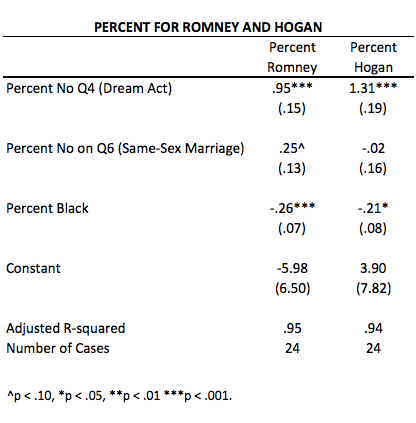 Yesterday’s post showed the strong relationship between the share who voted No on Question 4 in 2012 (the Maryland Dream Act) and support for Romney and Hogan across Maryland counties. Today, I look at models that control for other variables to test whether immigration or other factors best predicts support for Republican candidates in our state.
Yesterday’s post showed the strong relationship between the share who voted No on Question 4 in 2012 (the Maryland Dream Act) and support for Romney and Hogan across Maryland counties. Today, I look at models that control for other variables to test whether immigration or other factors best predicts support for Republican candidates in our state.
Immigration is Powerful
Immigration dominates other factors when explaining GOP support at the county level. The Romney model projects that Romney gained an estimated 9.5% additional votes for every 10% increase in the share who voted against the Dream Act.
Immigration has an even stronger relationship on the vote for Gov. Larry Hogan–he gained 13.1% more votes for every 10% who voted No on Question 4. So Hogan did a better job than Romney of magnifying the anti-immigration vote.
Same-Sex Marriage
Same-sex marriage was on the ballot in 2012 and a source of disagreement in the presidential campaign. As the state became the first to vote Yes on marriage equality, a 10% rise in support for marriage for equality cost Romney an estimated 2.5% of the vote.
Two years later, when support for marriage had increased further according to the polls, Hogan did his best to minimize discussion of the issue and take it off the table. He succeeded. Unlike for Romney, views on marriage equality had no impact on support for Hogan.
The Politics of Syrian Refugees
In his successful effort to win the Governor’s Mansion, Gov. Hogan downplayed his views on same-sex marriage. Hogan has wisely stuck with this approach of doing nothing to please social conservatives beyond stating his personal support for their viewpoint.
Immigration is also a complex issue for Hogan. A thumping majority voted for the Dream Act in 2012. Yet the above models demonstrate immigration’s strong salience to Hogan’s base. Politicians can only afford to tick off their base so much.
What to do? From a calculated political point of view, Hogan pleased his base by opposing Syrian refugees. He also probably doesn’t mind to the extent that his stand is being drowned out in the media by more hysterical reactions by other governors and presidential candidates, as it minimizes the number of alienated pro-immigrant voters.
Notes on Other Factors
Beyond the factors tested above, I also looked at the share of Asians and Hispanics as well as median household income. None had a significant impact on the support for Hogan or Romney once the immigration was included. I should note that income frequently has a bigger impact in surveys than at the aggregate level. Unfortunately, I had no easy measure of county attitudes on economic issues, as opposed to income. African-American areas voted more heavily Democratic according to the models but the impact is lower than one might expect after controlling for immigration.
